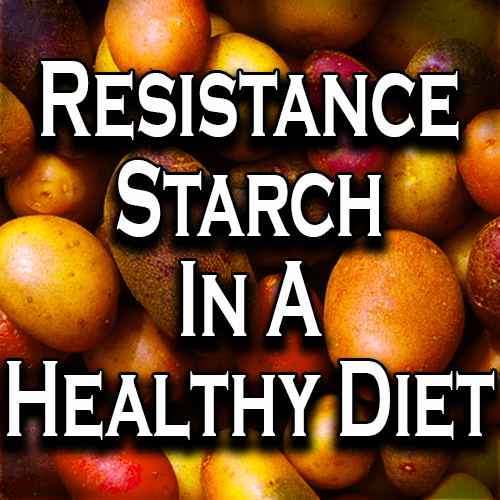Resistance Starch In A Healthy Diet

Beware of Resistance Starch In A Healthy Diet.
Resistant Starch in a Healthy Diet
You have a lot of control over your own health. Health and Happiness begins with a healthy diet, not a starvation diet.
An important part of healthy living is to include healthy foods in your diet.
- Most of the carbohydrates in our diet are starches.
- Not all of the starch we eat gets digested.
- A portion of these starches pass through the digestive tract unchanged. Also, labeled resistant starch “RS” because it is resistant to digestion.
- This resistant starch functions pretty much like soluble fiber. However, the small intestine doesn’t have the enzymes to digest fiber.
- It therefore reaches the large intestine undigested, and gets fermented by microbes.
- The large intestine, colon or “poop gut,” removes water, salt, and some nutrients.
- Certain vitamins are created as the starch ferments, but we do not need to go into detail here.
Fermentation Of Resistance Starch
The fermentation process also produces gasses that cause flatulence.
The friendly bacteria “gut flora” in the colon produce nutrients for the body. Also, short chain fatty acids feed the cells in the lining of the colon. This leads to reduced inflammation in the gut and results in improvements in various digestive disorders like Irritable Bowel syndrome, Crohn’s disease and Ulcerative colitis.
- High fiber foods usually have a lower glycemic index and cause smaller spikes in blood sugar.
- These foods also are slower to digest and you do not get hungry as soon. This is part of the “second-meal effect”.
- It is definitely true that fiber-rich foods tend to be healthier than low-fiber foods.
- That’s because high-fiber foods tend to be whole, unprocessed foods. These are healthy for many other reasons.
- Eating a wide variety of vegetables, including root vegetables (and maybe some fruit) should be more than sufficient.
- Although some fruit may have beneficial resistant starch, fruit is high in sugars and we should not overindulge.
Proceed With Caution
We need to be cautious about loading up on whole grains or pastas to get more fiber into our diet. Many people have problems with gluten and too many calories.
Some people say that fiber appears to be overrated. At any rate it is an essential part of a healthy diet. This is true if only for the sake of feeding the hundred trillion little dependents in the “poop gut”. They create many vitamins and other nutrients that keep us healthy.
Eating some starches especially beans and other legume’s, may result in a “second meal effect” that last into the second day. Much more needs learned about this, and too many starches may not be the best thing for diabetics.
The amount of resistance starch in a food changes. It changes when a raw food is cooked, and changes when a food is cooked in various ways. Also, it becomes different when cooked and then cooled. There is no easy way to measure the RS in food.
Raw potatoes, corn, rice, beans, lentils and other legumes appear to be among the foods with the highest amount of these resistant starches.
Surprisingly, carrots, beets and turnips and cereal grains have very little of resistance starch—it might be wise to limit them.
We don’t need to pay a lot of attention to Resistance Starch. Just include a wide variety of cooked and uncooked starchy vegetables in our diet.
| Tags | Category | Author |
|---|---|---|
| Tags: diet | jerry |